

Matthew Brown PhD University of Alberta Canada Overview About us Preprocessing quality assurance Interpretation of group vs individual differences Trial type fMRI signatures Dept Psychiatry ID: 933213
Download Presentation The PPT/PDF document "BIRS 2016: Opening the analysis black b..." is the property of its rightful owner. Permission is granted to download and print the materials on this web site for personal, non-commercial use only, and to display it on your personal computer provided you do not modify the materials and that you retain all copyright notices contained in the materials. By downloading content from our website, you accept the terms of this agreement.
Slide1
BIRS 2016:Opening the analysis black box: Improving robustness and interpretation
Matthew Brown, PhD
University of Alberta, Canada
Slide2OverviewAbout us
Preprocessing quality assurance
Interpretation of group vs. individual differences
Trial type fMRI signatures
Slide3Dept. PsychiatryDept. Computing Science
Computational
Psychiatry
Group
Slide4DiagnosisWhat disease?PrognosisPredict patient response to treatment options
Clinical decision-making
Slide5What are we detecting?10 psychosis patients, 10 controls, fMRI
H
ighly diagnostic Fourier power distribution from voxels IN THE EYES
Eye movement disturbances in psychosis
Slide6ADHD-200 and ABIDE datasetsn=1000 approx.
ADHD patients or autism patients
Structural MRI, resting state fMRI
Simple diagnosis
Classify patients vs. controls
A
ccuracy 50-70% in various papersSome papers reported higher 75%+ accuracy BUT cherry
-picking sites?
Slide7ADHD-200 Global Competition
Best-performing algorithm, but did not win
Used only non-imaging features:
Age, gender, handedness, IQ, site of
scan
3
-class classification (ADHD-c, ADHD-
i
, control)
63
% hold-out accuracy (vs. 54% chance)
Using non-imaging features
Brown et al. 2012
Chance accuracy
Validation
Accuracy (%)
Slide8Histogram of oriented gradient (HOG) features
Image from
Ghiassian
et al. under review.
Also see
Dalal
and
Triggs
2005. IEEE Computer Society Conference on. vol. 1.
IEEE
,
p
.886
–893.
Slide9ADHD-200 and ABIDE datasetsGhiassian
et al. under review
State of the art (as of 1.5 years ago)
2-class classification
(patients
vs.
controls)
ADHD-200
ABIDE
Chance
55%
51%
Non-imaging
69%
60%
Non-imaging + Structural MRI
70%
64%
Non-imaging + Functional
MRI
64%
65%
Slide10OverviewAbout us
Preprocessing quality assurance
Interpretation
of group vs. individual differences
Trial
type fMRI
signatures
Slide11Registration failure
Subject 1
Subject 15
Fixed ->
Standard preprocessing methods
failed for 1 of 21 subjects.
Slide12Inter-site variability
Sen
et al. in preparation
PCA Component 1
PCA Component 2
ADHD-200 Subjects Projected onto PCA component space
Each
colour
is a different scanning site.
Even
with standard normalization procedures, inter-site structure remains in the data.
Slide13OverviewAbout us
Preprocessing quality assurance
Interpretation of group vs. individual differences
Trial type fMRI signatures
Slide14Clinical research
Huntington’s
Image
from
Wikipedia
Healthy
One goal: Associate disease with biological features
Slide15ADHD-200 resting state fMRI functional connectivity analysis
ICA
Brown et al. 2012
Slide16ADHD patients vs. controls
“Default mode” network
Patients vs.
c
ontrols
Brown et al. 2012
“Desired” simple interpretation: “Patients are different from controls. This difference tells us something about the disease.”
Slide17Group vs. individual differences
Patients
Controls
Statistically significant
group
differences, but substantial overlap between
individual
patients and controls.
Brown et al. 2012
Slide18InterpretationSimple interpretation “patients are different from controls”
Overlap precludes simple interpretation
Yet many papers provide precisely and only the simple interpretation
Patients
Controls
Brown et al. 2012
Slide19OverviewAbout us
Preprocessing quality assurance
Interpretation of group vs. individual differences
Trial type fMRI signatures
Slide20Black box analysis
Analysis
Software
Slide21General linear model regression
Model voxel i’s
timecourse
Model matrix for trial type k
Slide22Two different models for hemodynamic response function
SPM canonical
model
Finite
impulse
r
esponse
m
odel
Slide23Check
deconvolved
timecourses
Basically agree
on
shape (
but not statistical differences in this case)
SPM canonical model
Finite impulse response
model, same region
Slide24Check
d
econvolved
timecourses
SPM canonical model
Finite impulse response
model, same region
Noise
in
deconvolved
timecourses
Slide25Another example
SPM canonical model
Finite impulse response
model, same region
Noise in
deconvolved
timecourses
Slide26GLM analysisCheck deconvolved
timecourses
What is the model fitting
Noise vs. signal
Model selection
regularization
Slide27SummaryQuality check everything
Visualization
Intermediate steps and final
results
Particularly important for non-technical end-users
Slide28AcknowledgementsPeople: Azad, Benoit, Dursun
,
Ghiassian
,
Greenshaw
, Greiner,
Juhas, Purdon, Ramasubbu, Rish
, Sen, SilverstoneFunding: AICML, AIHS, CIHR, Norlien
Foundation, AHS, AMHB,
UAlberta
Questions?
Slide29InvitationContinue informing other researchers about analysis pitfalls and caveats.
Questions?
Slide30Title